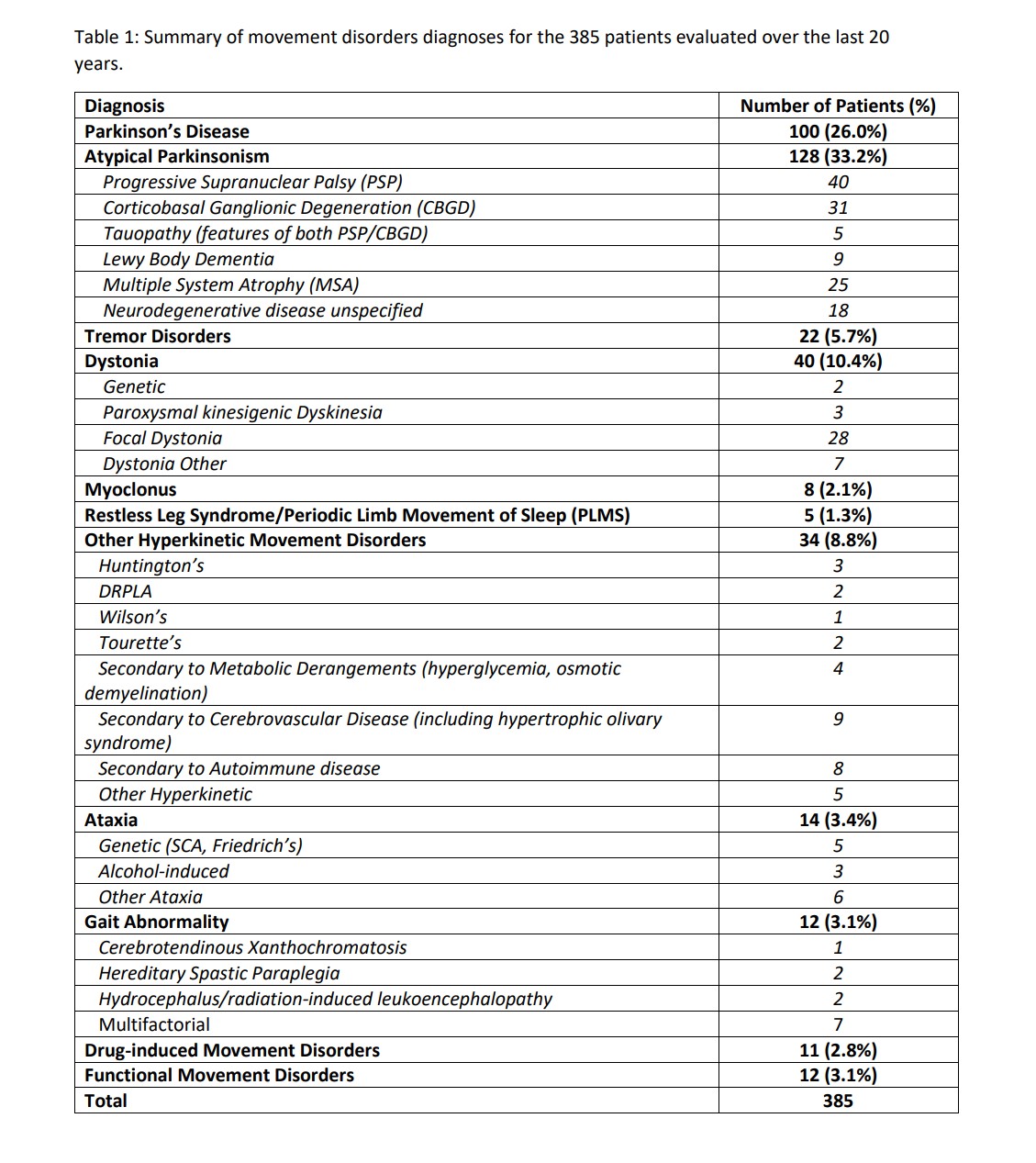Category: Education in Movement Disorders
Objective: To review the cases seen at Movement Disorder Video Case Conference between The Queen’s Medical Center and University of Virginia.
Background: In 2001, The Queen’s Medical Center in Hawai`i started a collaboration with University of Virginia to establish a video case conference for complex movement disorder patients.1 Hawaii is the only island state 2,000 miles from continental US. The video case conference served a dual purpose: an educational conference, as well as an alternative for patients travelling to the mainland for formal second opinion.
Method: A retrospective review of case summary was conducted.
Results: Before the patient was seen via video conferencing, the following information was shared with the group: medical history, laboratory results, imaging studies, current working-diagnosis and current treatment. The patient/family members were then interviewed and examined virtually. After the patient/family members left, each case was discussed thoroughly resulting in additional diagnostic and treatment recommendations that were shared with the patient at a later date.
A total of 385 patients were presented during the 20-year period. The diagnoses covered a wide range of movement disorders, including Parkinson’s disease, atypical parkinsonisms, tremor disorders, and rare disease, such as Hypertrophic Olivary Degeneration2 and Cerebrotendinous Xanthomatosis with spasticity (Table 1). Diagnostic dilemma (including test interpretation, atypical presentation, and interpretation of movement semiology) were discussed in 276 cases (71.7%) and management recommendations were given in 196 cases (50.9%).
Conclusion: The collaboration between the two institutions was made possible by early adoption of video technology, preceding the current wide adoption of virtual health.3 Providers in Hawai`i as well as patients with complex movement disorders in Hawai`i benefited from this format, receiving input in diagnosis and management without the need of long-distance travel. The video clinic thrived and continues to this day after 20 years with involvement and commitment from many physicians from both institutions who value this format. We hope that our video case conference serves as an example for others to build more collaboration between institutions.
References: 1. Queen’s makes connection with telemedicine. Honolulu Advertiser, May 28, 2001, Business Section C1/C4
2. Hypertrophic Olivary Degeneration. Bruno, MK, Wooten GF. Arch Neurol. 2012;69(2):274. doi:10.1001/archneurol.2011.657
3. Achey M, Aldred JL, Aljehani N et al. The past, present, and future of telemedicine for Parkinson’s disease. Mov Disord. 2014. Jun;29(7):871-83. doi: 10.1002/mds.25903. Epub 2014 May 17. PMID: 24838316.
To cite this abstract in AMA style:
M. Bruno, F. Wooten, M. Harrison, J. Liu, F. Gao, B. Shah, J. Del Castillo, A. Mauro. A Retrospective Case Review of Movement Disorder Video Case Conference ~ A 20-year Collaboration Between The Queen’s Medical Center in Hawai`i and University of Virginia [abstract]. Mov Disord. 2022; 37 (suppl 2). https://www.mdsabstracts.org/abstract/a-retrospective-case-review-of-movement-disorder-video-case-conference-a-20-year-collaboration-between-the-queens-medical-center-in-hawaii-and-university-of-virginia/. Accessed April 2, 2025.« Back to 2022 International Congress
MDS Abstracts - https://www.mdsabstracts.org/abstract/a-retrospective-case-review-of-movement-disorder-video-case-conference-a-20-year-collaboration-between-the-queens-medical-center-in-hawaii-and-university-of-virginia/

